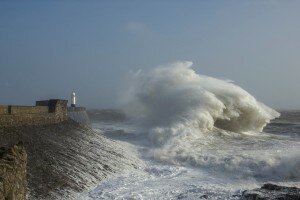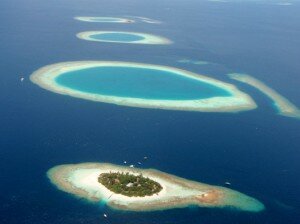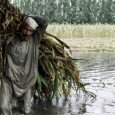By Haroon Janjua –
Climate Change Threatens to Submerge Surfaces of South Asia
A report published by the U.N Intergovernmental Panel on Climate Change (IPCC) titled “Renewable Energy Sources and Climate Change Mitigation 2015” followed by its previous year’s report, “Climate Change 2014: Impacts, Adaptation, and Vulnerability” has led to an impassioned discourse in the South Asia climate expert fraternity, especially given our region’s vulnerability to the vagaries of the forces unleashed by the climate change phenomena.
Recent research on climate change across the planet is now also reviewing the need for engagement of cross section of earth’s populations in response to challenges being faced. Climate change and global warming along etc. pose an especially grave risk to South Asia.
The IPCC research findings are quite insightful. Even if we discount the doomsday scenarios it alludes to, it is not difficult to connect climate change catastrophes with religion conflicts across the world with potentially profound impact on the state of global order and prosperity.
 Now the question, why South Asia is so severely impacted by climate change?
Now the question, why South Asia is so severely impacted by climate change?
For decades the region’s governments and political discourse ignored climate change as an issue. Growing industrialization, exploitation of natural resources led to ecological problems of nightmarish proportions and also for the traditional ignorance and indifference of the masses towards environmental issues. Off late, several research reports have been published that point towards entire populations in the region exposed to climate change hazards. The rapid onset of climate change puts South Asia in greater peril, and under threats of flooding, food shortages, migrations, fragile economy and natural disasters.
Although climate change phenomena is unlike to spare any part of the world, its debilitating impact upon the region comprising Afghanistan, Bangladesh, Bhutan, India, Maldives, Nepal, Pakistan, and Sri Lanka is anticipated by experts to be highly incredible. Researchers conclude that climate changes precipitated colossal natural disasters last year in Asia, accounting for 30 percent of worldwide economic loss attributed to natural disasters. The region’s population has a heavy reliance on natural resources and weather patterns for its economy – agriculture, irrigation, fisheries, forestry.
“Extreme events increased monsoon intensity, hot days are immensely increasing precipitation level will decrease from 10-20 percent from December-February during a century while it may decrease 30-50 percent from September–November during a century”, says Ali Tauqeer Sheikh, climate expert and CEO LEAD Pakistan. “South Asia is the monsoon’s child, and the timing of the monsoon season is fluctuating across the region, and unpredictable torrential rains can cause urban flooding while less intensity of rains cause food shortage”.
The bulk of the region’s countries are poor, struggling to meet the basic needs of their growing population, with its vulnerable population spending bulk of its means on food for subsistence, they are most prone to climatological disturbances, making staples unavailable. In addition, the region’s massive population growth has negative socio-economic consequences, with the greatest risk to populations living in vulnerable locations and in abject to extreme poverty. According to Food and Agriculture Organization (FAO) “Most of the world’s undernourished people are still to be found in Southern Asia, by 2050, climate change and erratic weather patterns could have pushed another 24 million children into hunger.”
 “Climate change poses a threat to many areas in South Asia in terms of agricultural productivity due to effects on water supplies, water uses, crop yields, extreme events and land inundation from sea level rise,” says Bruce A. McCarl, professor of Agricultural Economics at Texas A&M University.
“Climate change poses a threat to many areas in South Asia in terms of agricultural productivity due to effects on water supplies, water uses, crop yields, extreme events and land inundation from sea level rise,” says Bruce A. McCarl, professor of Agricultural Economics at Texas A&M University.
“Research into adaptation is not occurring in South Asia adequately. Further, research into Climate Change adaption could involve a gestation period of few years to decades. For example, development of temperature or drought tolerant crop variety, identifying temperature tolerant forestry species, etc. would take decades of research,” said Professor N H Ravindranath, a climate change expert in India. “Since South Asia is one of the most vulnerable regions to be impacted by Climate Change and a large proportion of the population is vulnerable too, the policy makers should play a constructive role in achieving a global agreement at UN Climate Convention in Paris in 2015”.
Changes in the region’s weather patterns and heavy monsoon season and glacial melting can gradually destroy populations and infrastructure. Rising sea level threatens Kolkatta, Mumbai and Karachi, collectively home to some 50 million people and rising. These cities have, in the recent past, experienced massive flooding, leaving the state crippled, with people were left to fend for themselves, not to mention much of the infrastructure had to be rebuilt. Although on relatively higher ground, an elevation of 8 meters from mean sea level, Dhaka will suffer from drainage congestion resulting from heavy rainfall.
Bangladesh’s low-lying areas are exposed to cyclones from the Bay of Bengal and storm surges are predicted to rise dangerously in coming decades. In 1991 a storm followed by a cyclone killed 140,000 people in Bangladesh and left 10 million homeless.
The UN’s Environment Program predicts one meter’s rise in sea level, engulfing 17,000 square kilometers of Bangladesh, or nearly 10 percent of its arable land, a serious hazard to a country where the agriculture constitutes 20 percent of its GDP.
 Islands of Maldives are prone to devastating climate change. It is expected to submerge under rising sea levels in another few decades, leaving not even a hint of those beautiful islands that have attracted tourists over the years. Maldives’ Minister of State for Environment & Energy Abdullah Majeed, showed his concerns that many islands will be wiped out, regardless of the outcomes of COP 21 at Paris in December 2015.
Islands of Maldives are prone to devastating climate change. It is expected to submerge under rising sea levels in another few decades, leaving not even a hint of those beautiful islands that have attracted tourists over the years. Maldives’ Minister of State for Environment & Energy Abdullah Majeed, showed his concerns that many islands will be wiped out, regardless of the outcomes of COP 21 at Paris in December 2015.
When the monsoon arrives in full strength in Nepal, farmers will be hit hard. Apart from shelter, they need to save their crops from storms and torrents. Off late, farmers are witnessing heavier and more erratic rainfall during the monsoon period, often flooding their rice field, putting a lot of stress on farmers’ already fragile resources and food security.
South Asia has suffered serious threats due to high rainfall causing floods on the one hand, while on the other hand scant rainfall leads to drought and famine. Intense heat has started affecting the sowing, cultivating and harvesting patterns of the fertile agricultural lands along the Indus in Pakistan, and in northern India and Bangladesh. Wheat and rice productions in the region may decline by up to 50%, by 2100, affecting livelihoods of a substantial section of its farming populations and also impacting the region’s food security.
Water scarcity is already a crippling problem and South Asia is fast hurtling towards becoming one of the world’s most water stressed regions, and as such the IPCC warns, South Asia shall have the largest numbers of food-insecure people by 2050.
South Asians states have to spend heavily in both extenuation and adaptation, to overcome the challenges posed by climate change phenomena. Hampering this humongous task, to contain the extreme damage to the region, are lack of international funding and dearth of regional cooperation between South Asian countries.
Climate Change has off later begun impacting food production, forest biodiversity, water resources, fish catch and is increasing the incidence of vector-borne diseases. Hence, policy makers must not consider Climate Change as a distant phenomenon that is decades away, they must appreciate it as an ongoing concern with the need for building resilience in the communities.
 The need of the hour is for the leaders of South Asian nations to come together, draw out action plans to reduce air-pollution, prevent deforestation and plan water conservation, linking of rivers to prevent floods, handling emergencies like cyclones, tsunamis, etc and develop sustainable sources of energy. For this, expert committees should be formed for in depth studies of the problems and submit blueprints and seek monetary assistance from international support bodies.
The need of the hour is for the leaders of South Asian nations to come together, draw out action plans to reduce air-pollution, prevent deforestation and plan water conservation, linking of rivers to prevent floods, handling emergencies like cyclones, tsunamis, etc and develop sustainable sources of energy. For this, expert committees should be formed for in depth studies of the problems and submit blueprints and seek monetary assistance from international support bodies.
SAARC Secretariat should establish a special branch to deal with this problem in tandem with other regional organizations like the ASEAN who are also facing similar threats and are working out their plans on haze pollution, energy security, clean climate, wildlife protection, preventing deforestation and saving coral reefs in the Asian seas.































































































